Nav
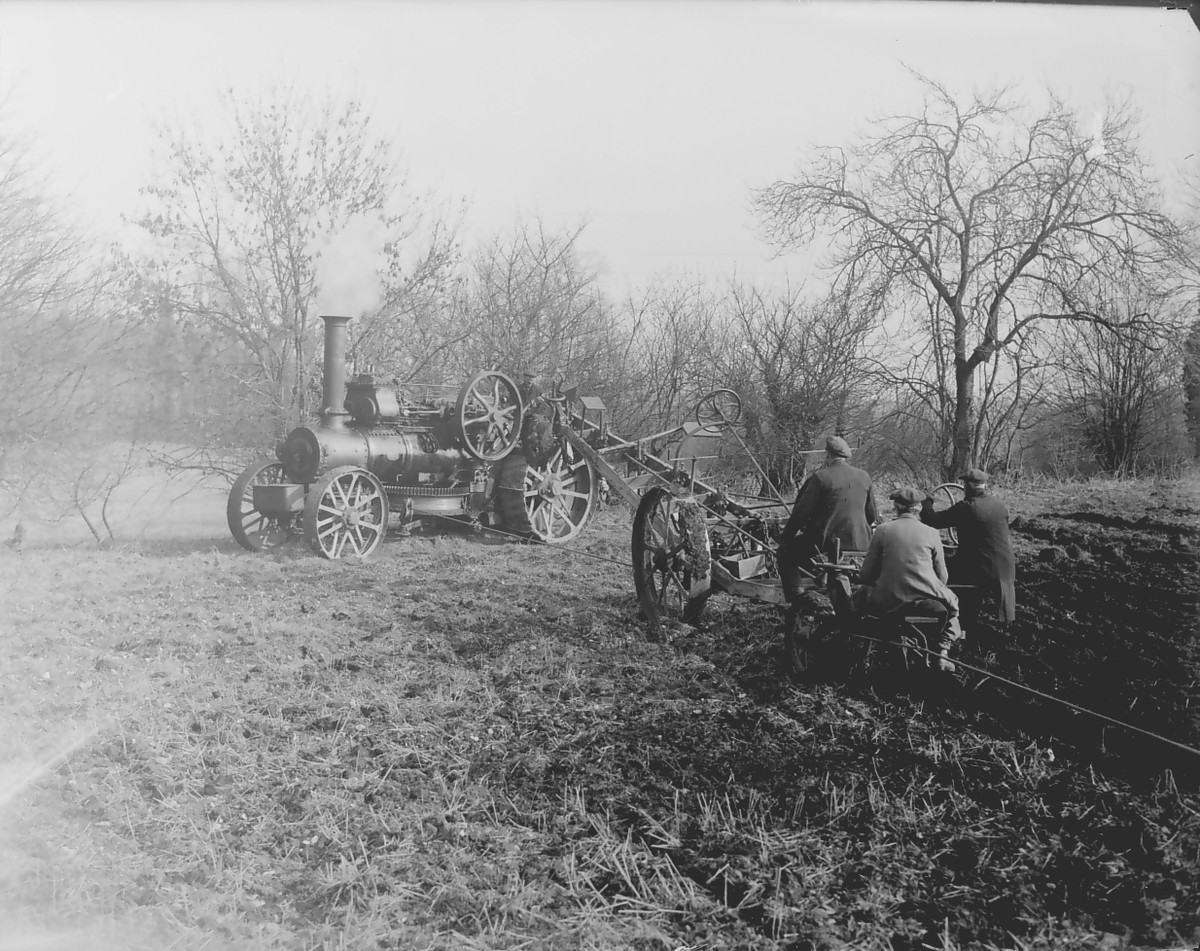
Ploughing Mechanisation: A Brief History
The industrial revolution had moved many farm workers away from agriculture to seek a new and more prosperous life in the developing towns and cities. As agricultural workers moved away from rural areas, farmers had fewer hands to help them with cultivating and harvesting. The growing urban populations meant a bigger demand for food production at a much faster pace. Farmers now needed more efficient ways of working.
Ploughing was one of the most important jobs of the agricultural year, as it laid the foundation of a good harvest in the autumn seasons. It was a hard, slow job which relied on strong horses or oxen and a good knowledge of the land that was being cultivated. Different areas of the country had their own types of plough which was better suited to the local terrain. For many years, this type of ploughing was the only way to get the job done affordably and efficiently.
When steam engines were introduced to the farm, they were static engines that would power tools like threshing machines. These would normally be in the yard where horses would have initially done the same job. As steam engines were developed, makers added wheels to these machines, and they were able to be pulled to work by horses to power implements including the plough.
P DX 289/687
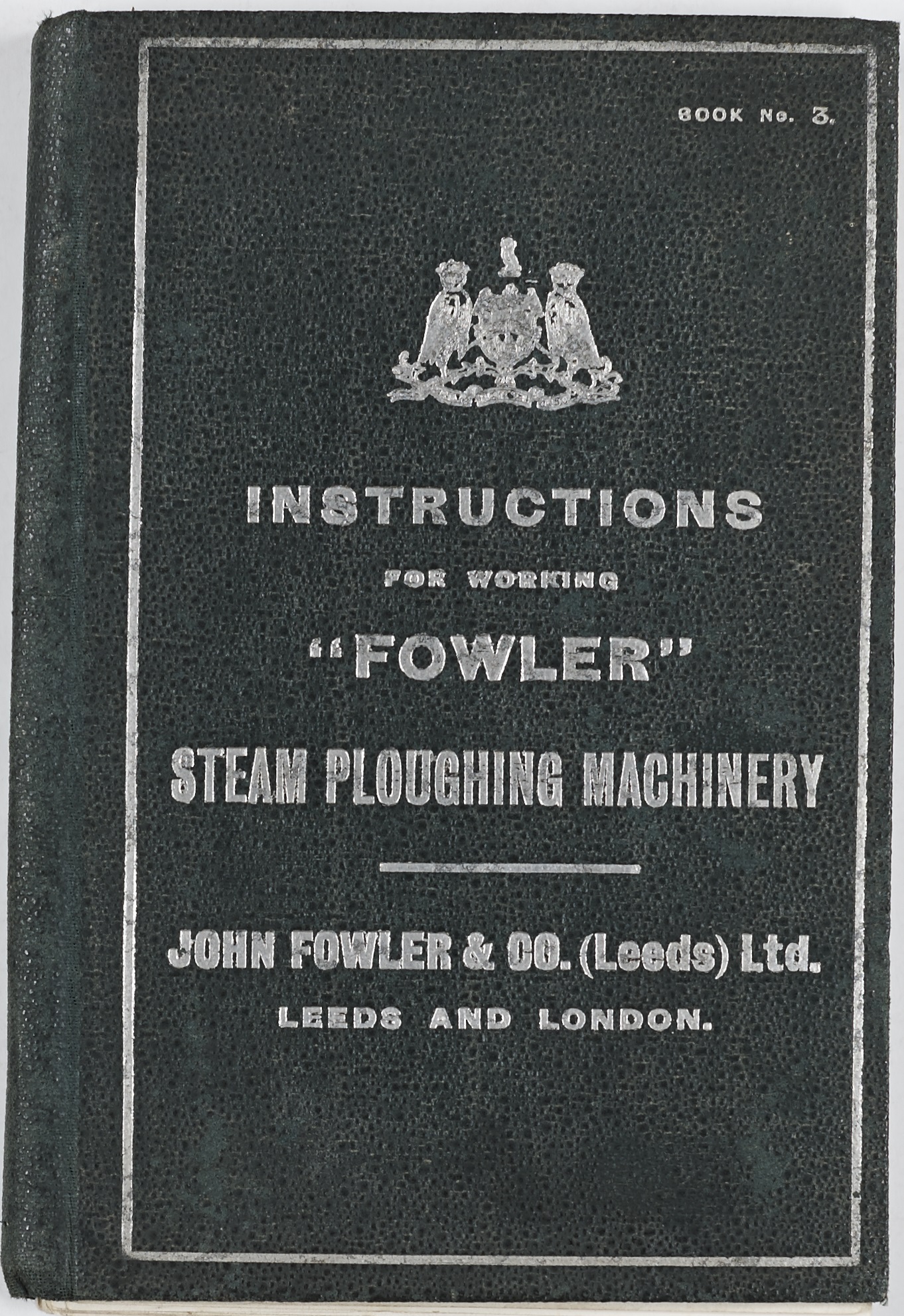
How to Plough
In the early trials a single engine and a windlass was used. The plough was drawn back and forth across the field via a windlass driven either by a belt or solid coupling from the engine. The anchors, rope-porter, pulleys etc had to be moved manually while the engine and windlass stayed in the same place. A self-moving anchor was developed later where the engine had a double drum: one to take the loaded rope and one for the tail-end rope. This became known as the Roundabout System.
Earlier steam cultivating used a roundabout cable system with one engine. However, the two-engine system soon came into use and was preferred for its practicality. This is what is usually seen today at demonstrations.
TR DX1249/1
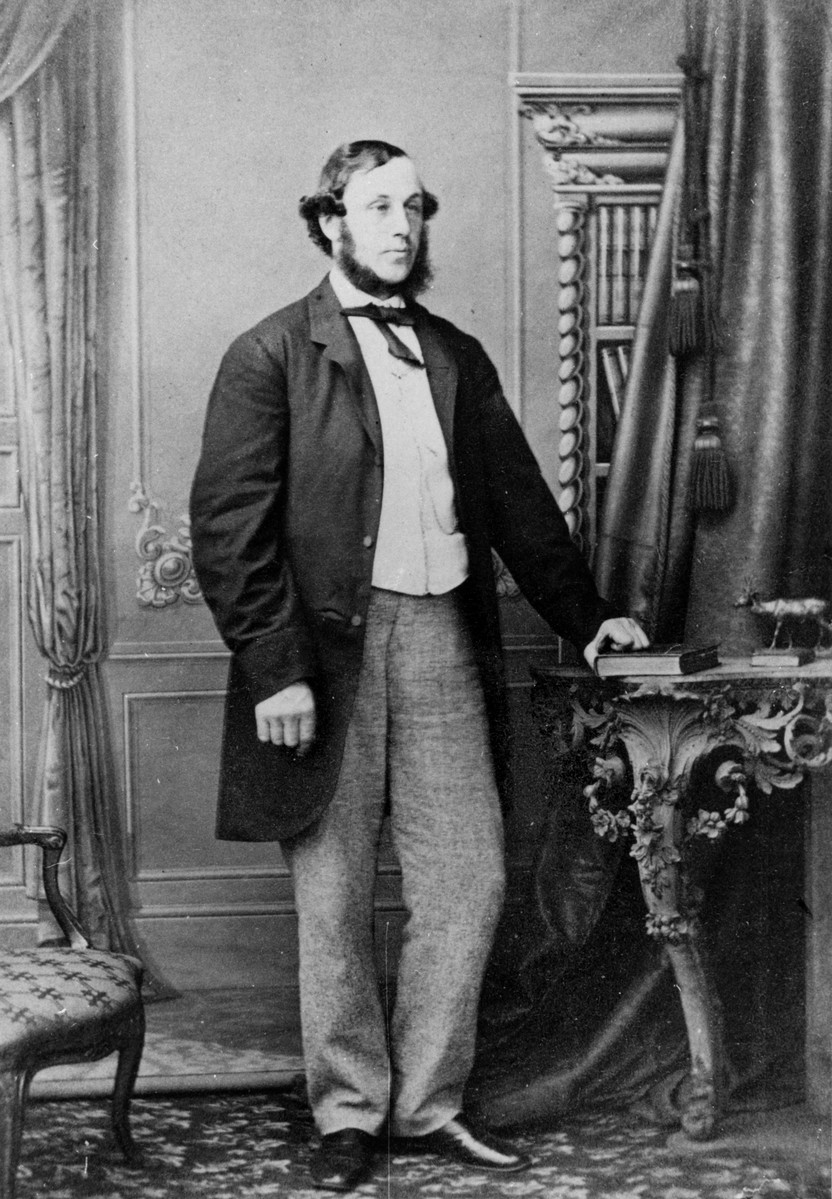
John Fowler
John Fowler was born in Melksham, Wiltshire to wealthy Quaker parents on 11th July 1826. An inspiration for his inventions came after a holiday to Ireland in 1849. Fowler saw the devastation, poverty and starvation caused by the Irish potato famine and felt there must be an invention that would help prevent this disaster happening again and make the production of food much cheaper and less prone to disaster in the long run.
Fowler wanted to help reclaim bogland by improving drainage which would allow farmers to wield better and more regular crops. His first invention was a mole plough. The machine, powered by horses, dragged itself across the field on rollers, pulling the mole plough as it went. The mole would have drainage pipes attached behind and these would be laid in the channel created by the mole. On completing each length of drains, the engine would be turned and repositioned ready for the next row.
In the early stages of his company Fowler often outsourced much of his manufacture to other companies such as Clayton and Shuttleworth or Ransomes of Ipswich. His enthusiasm for his work and his ability to solve problems creatively helped him to have long standing working relationships with many people throughout his short lifetime.
TR 7FOW PH3/1
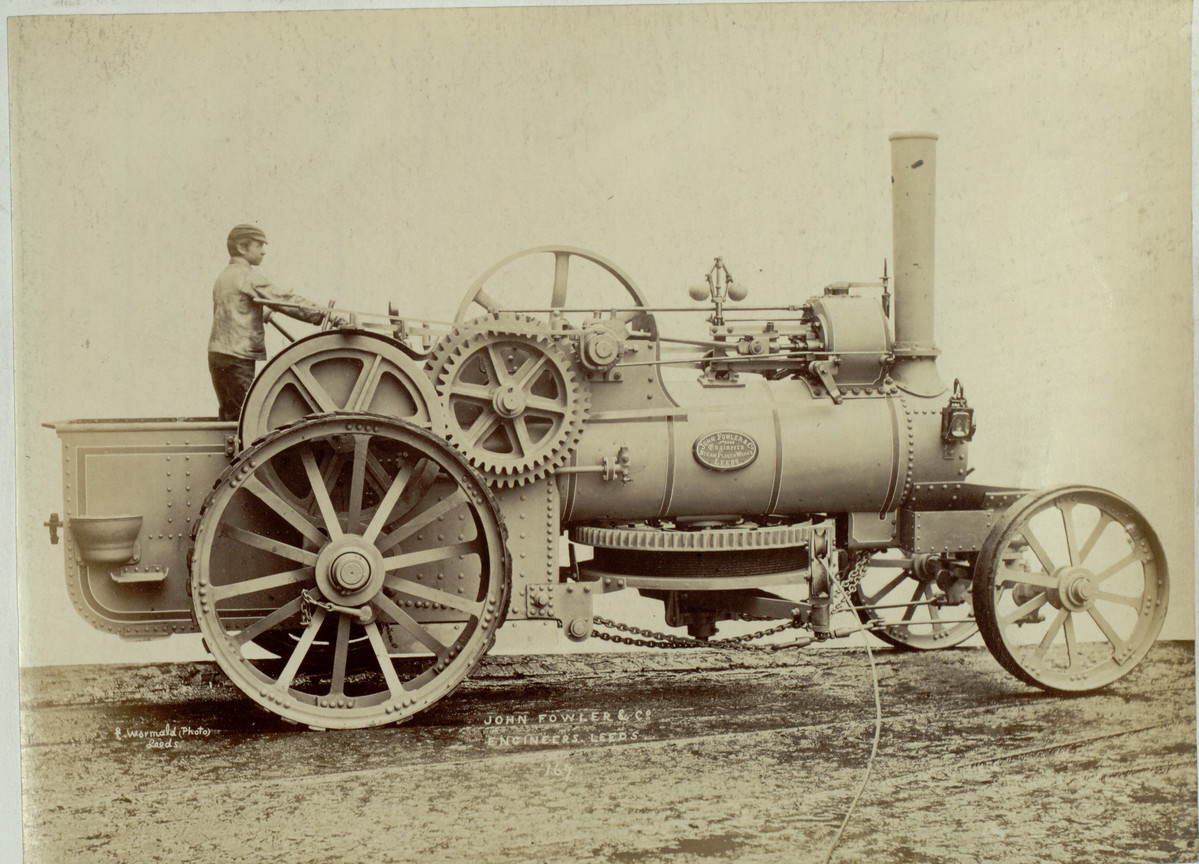
Ploughing Trials
As technology developed, influential bodies like the Royal Agricultural Society of England (RASE) were interested in finding the most efficient and cost-effective ways to improve farming. They held prize competitions for inventors to showcase their ideas for improving farm work including Ploughing Trials, which would include the emerging use of steam. The steam plough competitions would require the competitors to plough an acre of land as quickly and as cleanly as possible but the judges would also consider the price of the machine and how well the work was done in comparison to horses.
John Fowler exhibited his inventions in a number of these trials. Whilst many of his attempts proved his engineering was sound, he did not necessarily provide assurance that the job could not be done more cheaply by horses. By then the prize had been increased to a coveted £500; a large sum for those day, worth about £62,000 today.
The first contest was held at the Society’s summer meeting in Carlisle in 1855 with more events at Chelmsford in 1856 and Salisbury in 1857, without an award being made to any of the participants.
The judges however awarded a medal to John Fowler as a reward for his strenuous endeavours, adding, ‘Steam ploughing as such had attained a degree of excellence comparable in point of execution with the best horse work’.
TR FOW PH2/1/142
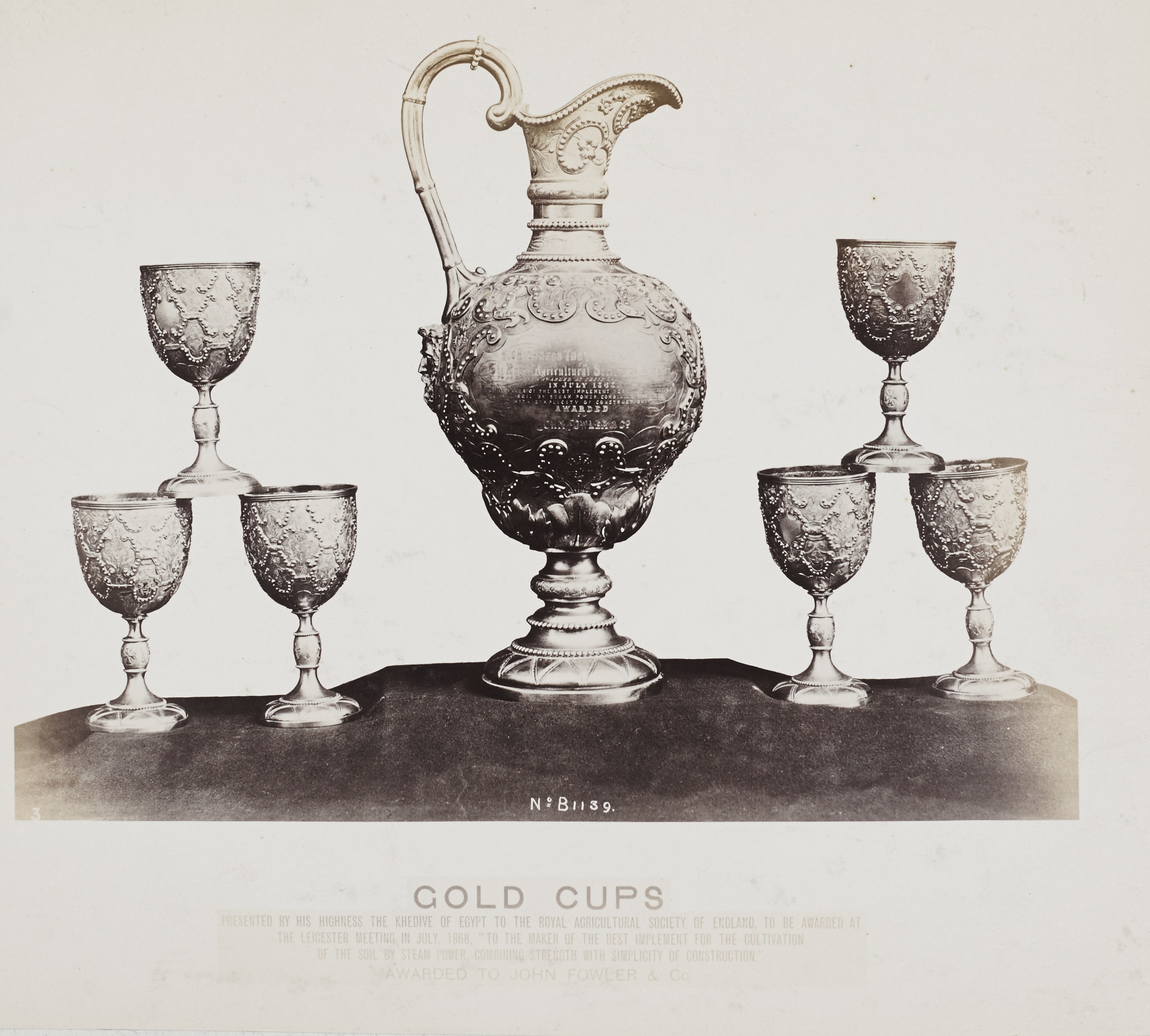
Success at the Chester RASE Ploughing Trials 1858
After further experimentation, he competed at the RASE trials held in Chester in 1858. Fowler was up against Thomas Rickett’s rotary steam cultivator, Charles Burrell’s direct traction plough, and William Smith’s own roundabout system.
The judges announced Fowler the winner in the Autumn of 1858, adding in their report that:
‘It is beyond question that Mr. Fowler’s machine can turn over the soil and in an efficient manner at a saving compared with horse labour; while in all cases it is left in a far more desirable condition and better adapted for all the purposes of husbandry. We are unanimously of the opinion that he is fully entitled to the prize of £500’.
TR FOW PH2/17/B1138
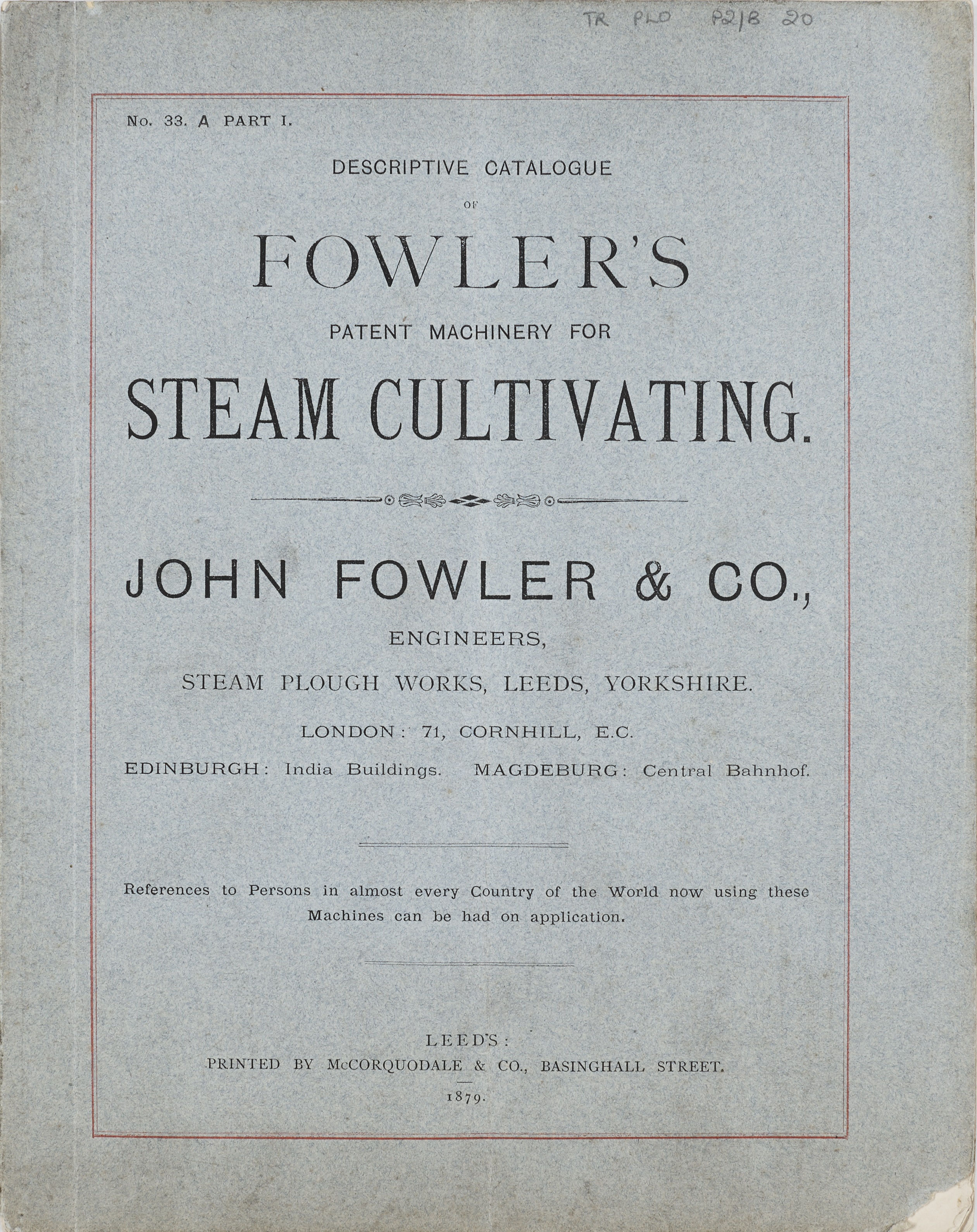
John Fowler & Co.
In 1851 Fowler felt that £150 was too expensive for the average farmer to pay for a drainage machine and he worked hard to create a contract that would save the farmer 35%-65% on costs to use his machine. He also created a hiring scheme by day or month for those who could not afford to purchase one.
Fowler set up his own manufacturing business in Leeds in around 1856 as a civil engineer, where he collaborated with an Essex farmer, David Greig, who was instrumental in helping Fowler apply his steam ploughing ideas to the land.
It was apparent through the work of Fowler, that he kept the farmer in mind throughout his inventing career. Fowlers sent a trained man with all the new tackle they sold to instruct the local men in the handling of engines and implements. The new purchasers often offered these men reimbursements to stay on. It then fell on these men to explain to those who could neither read or write the rudiments of driving steam engines or steering the plough and cultivator.
In 1875 the cost of a Fowler single cylinder ploughing engine and roundabout ploughing tackle was about £845.00 and a Burrell was £791.00. In 1875 Fowlers supplied 142 new engines and their production peaked the following year when they supplied 212 machines. Gradually the use of the double-engine system became established and by 1879 the data suggests that there were as many as 1,623 ploughing engines in the UK.
TR PLO P2/B20
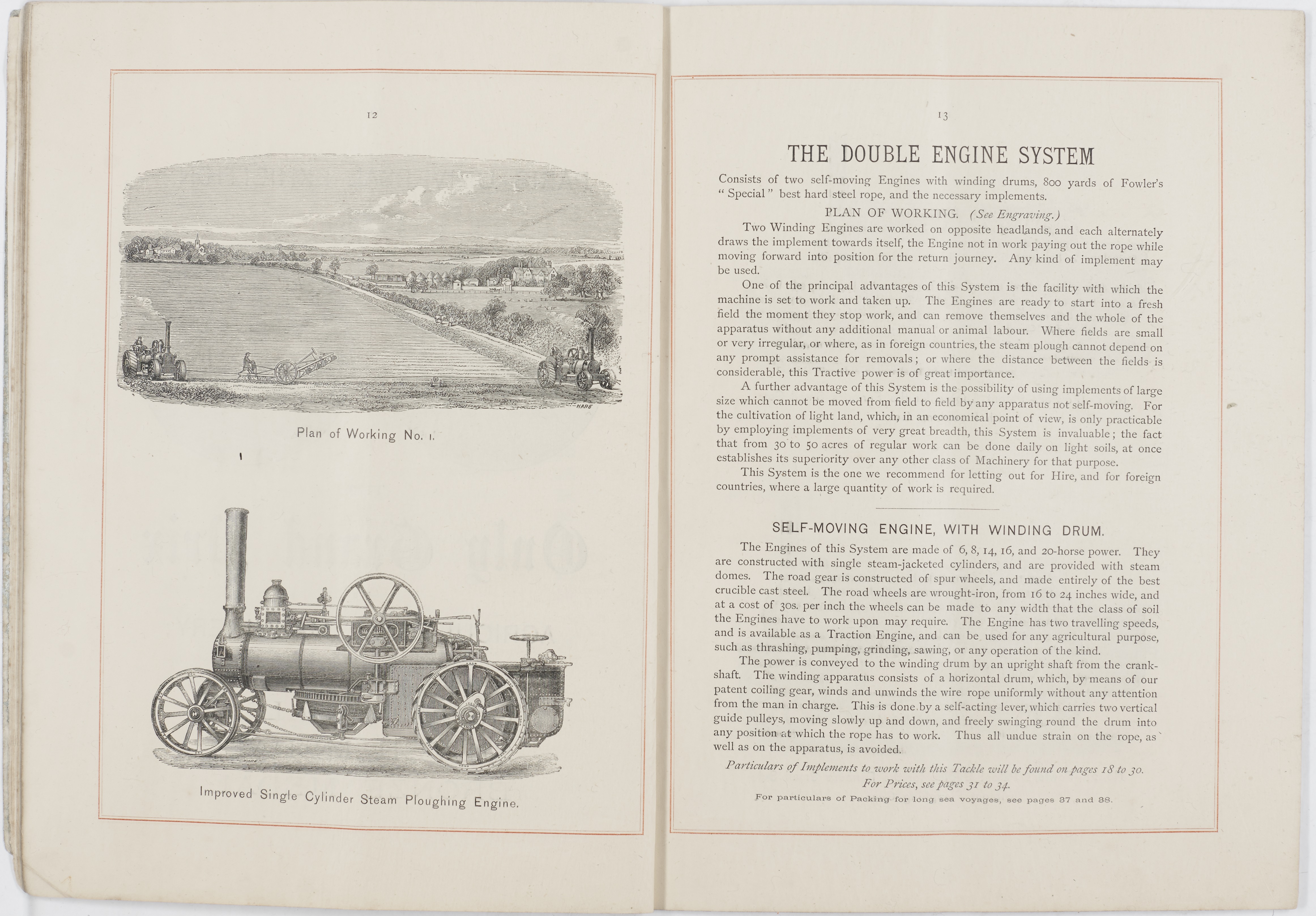
John Fowler & Co.
In his 1859 catalogue each machine part was labelled to make replacements easy. In 1860 another Fowler catalogue suggested the machinery was so easy it could be worked by ‘the ordinary farm labourer… and very few parts that cannot be put back in order by any blacksmith’.
Most steam ploughing and cultivation was undertaken by contractors. Many farmers, other than the largest landowners, found the initial cost too high to justify investment. Each set of tackle usually comprised four men and a boy living together in a van which travelled with the engines, implements and water cart.
Fowlers dominated the ploughing engine market and supplied 2,146 of the 2,450 cable ploughing engines sold in the UK. They also supplied the overseas market and between 1880 and 1915 91% of John Fowler ploughing engine sales were exported.
TR PLO P2/B20
Fowler around the world

Fowler around the world
Italy
Mainland USA
Hawaii
Chile
France
Brazil
Scotland
Australia
India
Trinidad
Egypt
China
Prussia / Germany
Russia
South Africa
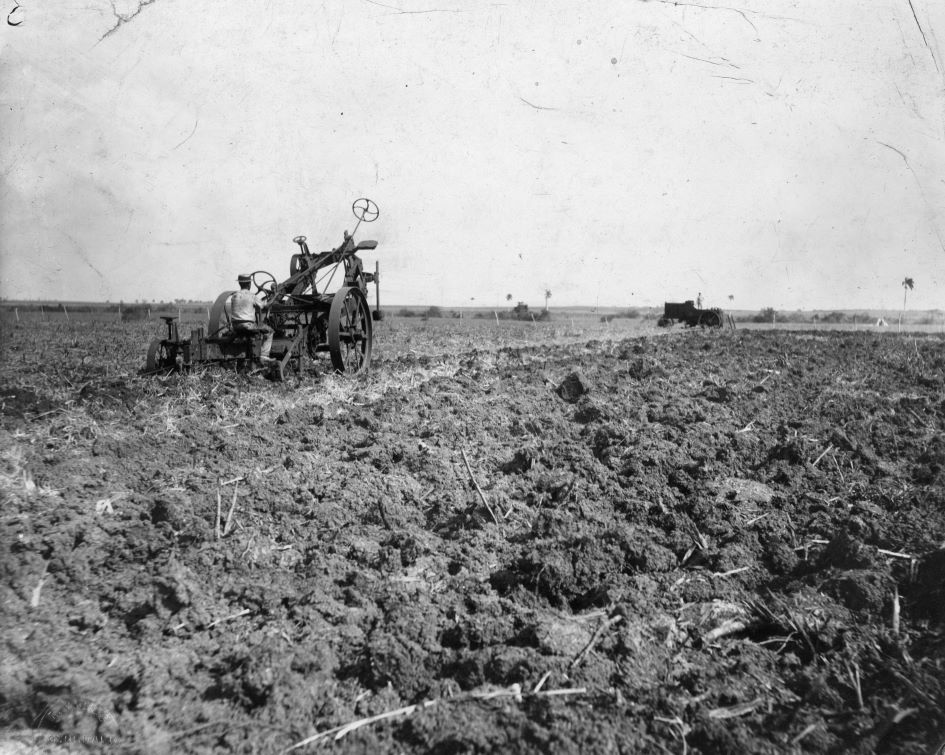
Italy
After setting up an office in Rome, Fowler sent representatives to inspect the work being done with their engines. One representative, T. A. Smith, met Mussolini twice on the Pontine marshes.
On one occasion, he witnessed a ploughing competition between continental engines. Despite a last minute repair job when the 5” dia clutch socket was sheared off, destroying the roller bearing, they won the competition. Smith wrote that “the next day our engines ploughed all day without mishap and all the continental engines had to give up due to breakdowns of various kinds.”
This image shows a Fowler balance cultivator and motor cable ploughing engine at work in Italy.
TR FOW PH3/13
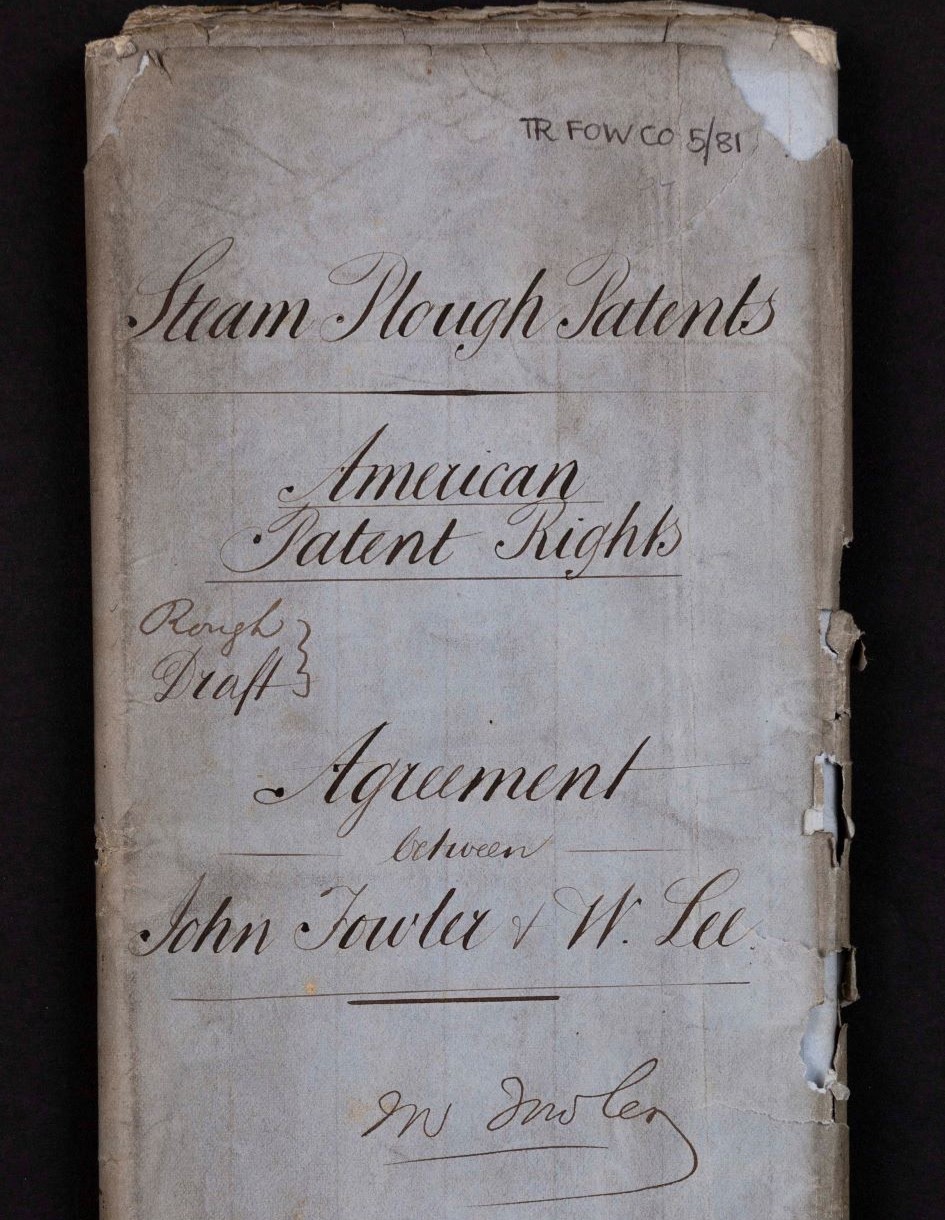
Mainland USA
Fowler steam ploughs were of particular interest to American markets, who could see utility for it on the western prairies. The Fowler steam plough was patented in the US in 1861, and the first double-engine set was imported in 1867. Effingham Lawrence used it on his Louisiana sugar plantation and was so enamoured with it that he soon ordered two more sets, becoming a spokesman in favour of steam powered agriculture.
The USA typically favoured rotary ploughs, so the cable system never became widespread. Few steam ploughing machines were imported by 1870, but those that were introduced were almost exclusively Fowler engines.
TR FOW CO5/81

Hawaii
The sugar trade was extremely lucrative in Hawaii throughout the 19th century. As a result of the Reciprocity Act in 1876, Hawaiian sugar imports into the USA had no duty enforced upon them. Railway transport was highly sought after due to the high bulk of the sugar crop. Many plantations ordered steam locomotives and portable track from Fowler. George McFarlane, who was employed by Fowler, was a close friend of King Kalakaua.
Kilauea, Spreckelsville and Waianae plantations all used Fowler locomotives to increase the efficiency of their sugar cane transportation.
TR 10FOW PH3/2
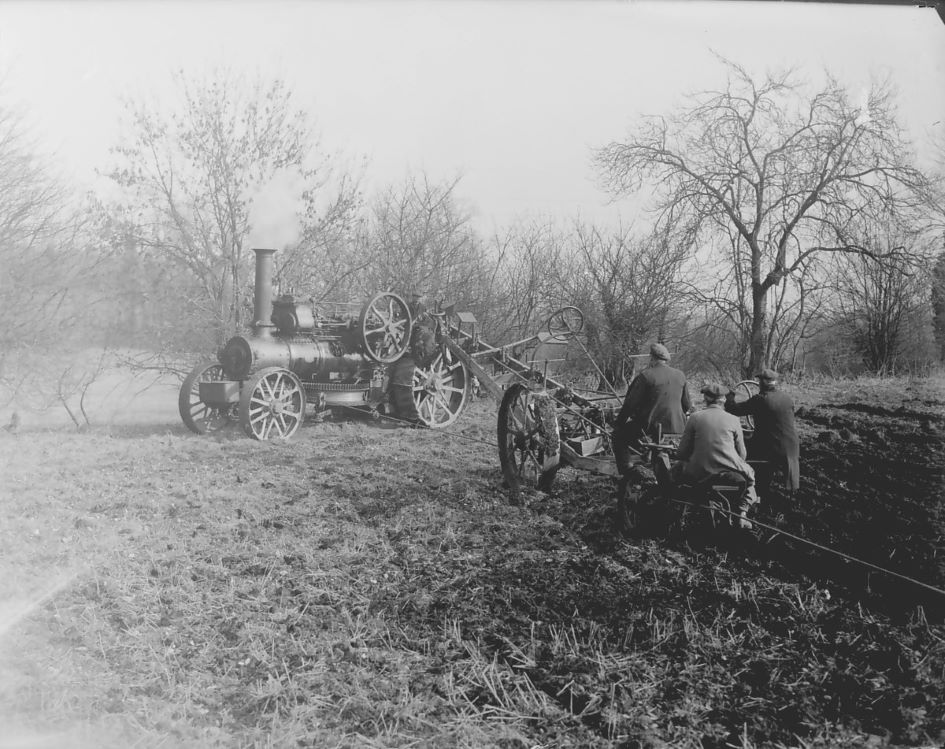
Chile
Fowler played a key role in initial attempts to mechanise agriculture in Chile. In Parral district, Chillán province, the foreigner Nicolás Schuth introduced Fowler steam traction engines to trial the ‘cable system’. This involved two 10 hp stationary steam engines located at opposite ends of a field, 400 yards apart. They alternately pulled the plough back and forth across the field. The system could plough one cuadra (just under four acres) in three and a half hours.
Due to difficult and hilly terrain the plough met with limited success. Reaping technology was typically more widespread as it reduced manpower required by 11 workers per cuadra. Threshing machines were also enormously popular.
The across image shows steam cable ploughing in action.
P DX289 PH1/687
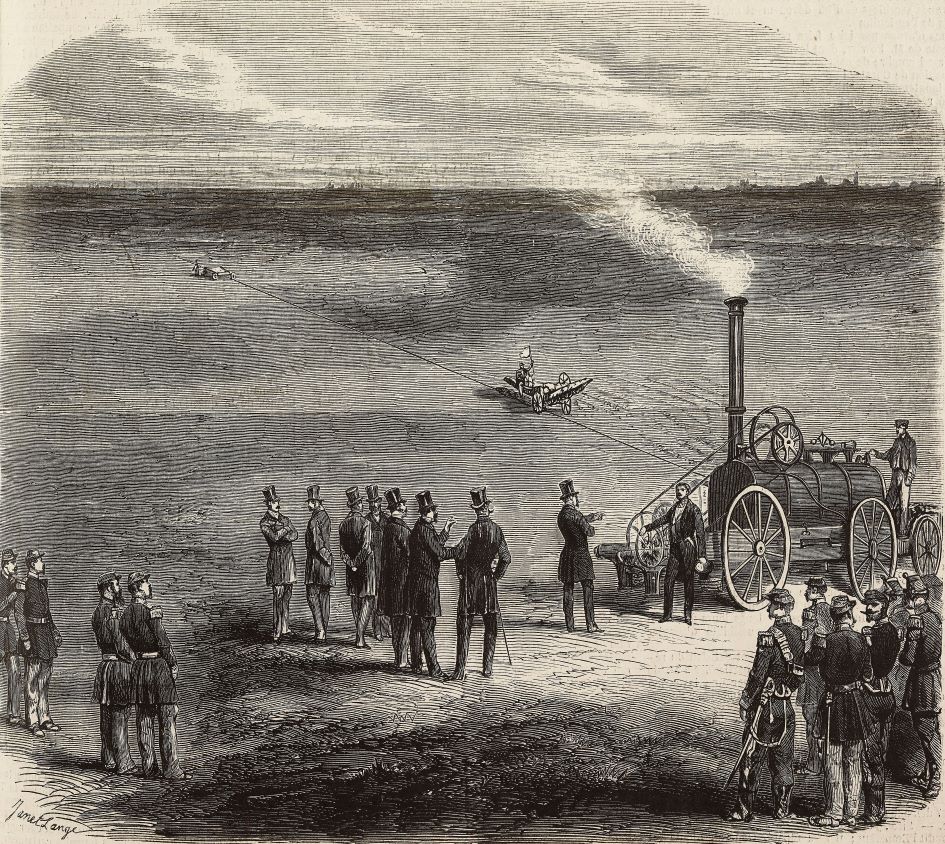
France
The Société Agricole de France held steam ploughing trials in France in 1867 and 1868. During one set of trials, a board of judges from France, Russia, Italy and Austria reported on the “incontestable superiority of the Fowler tackle over that of their competitors”.
In 1868-9, Fowler was awarded the ‘Médialle Agricole’ twice by Napoleon III and around ten thousand farmers gathered on the plains of Barry to watch a ploughing demonstration involving a double engine tackle.
This image shows an illustration of Napoleon observing a Fowler steam plough in the 1860s.
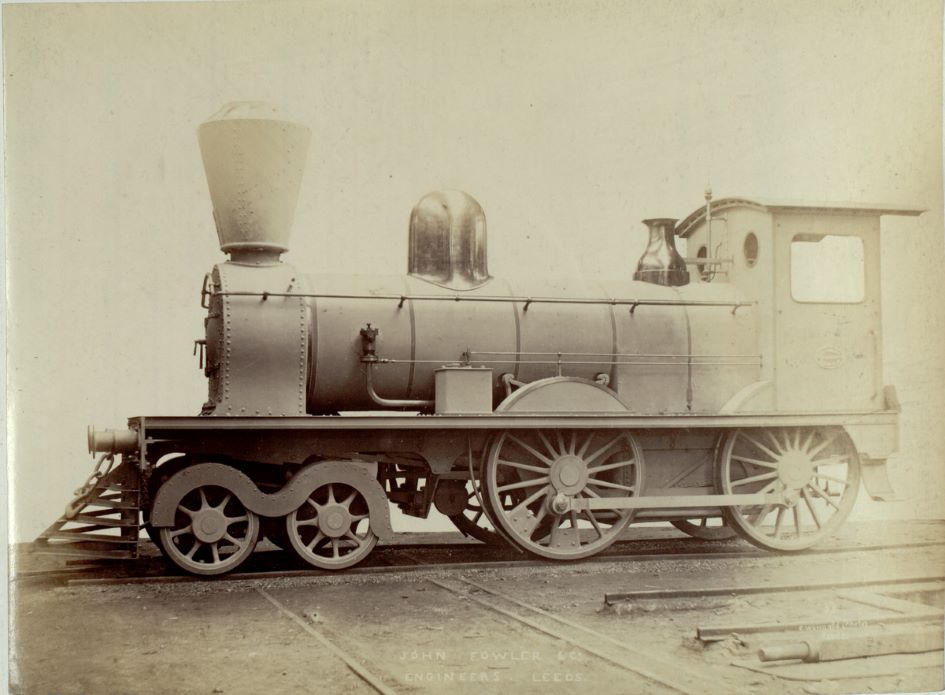
Brazil
Brazilian railway companies were first established in the 1860s. One of these, the Companhia Paulista de Estradas de Ferro, built workshops in Jundiaí and Rio Claro in the 1890s. These workshops assembled and repaired railway locomotives, some of which came from John Fowler & Co.
The across image shows a Fowler Express Locomotive, designed for the Brazilian railways.
TR FOW PH2/1/W75
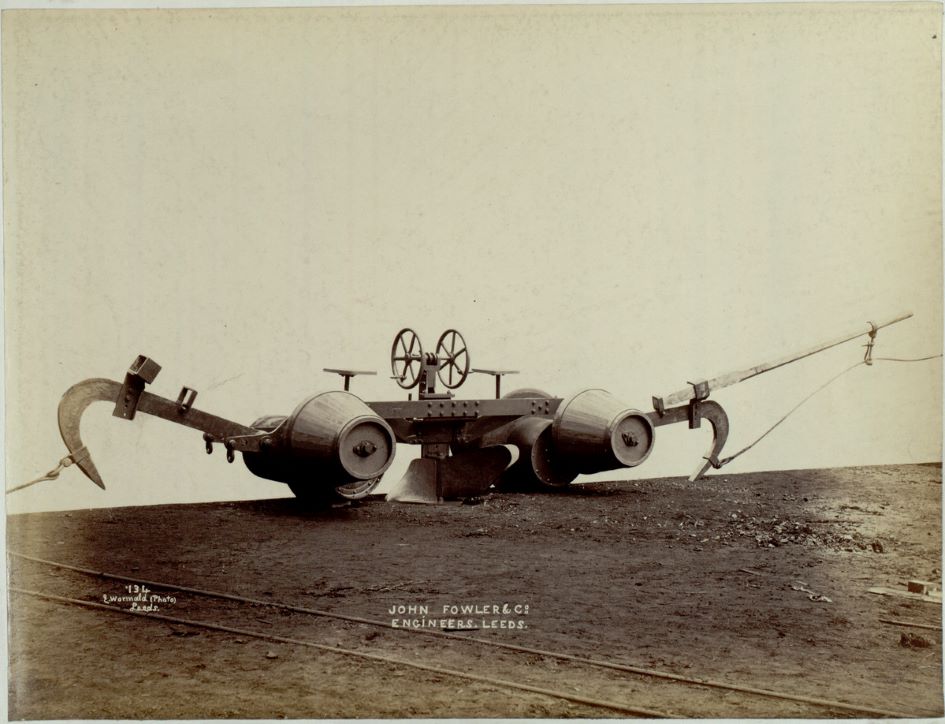
Scotland
Fowler was at the forefront of marketing English steam machinery in Scotland. At the 1870 Royal Highland Show, eight of the fourteen steam engines present were manufactured by English companies, but only one – Fowler – had a branch in Edinburgh. At this time, steam power was used less for cultivating soil but did have a key role in powering barn machinery and for other farm work.
Between 1869 and 1885, the Duke of Sutherland undertook a massive land reclamation project in Scotland using Fowler steam technology. He owned a million acres of poor quality arable land, which included hills and bogs. The Duke purchased eight steam plough sets and hired hundreds of labourers. Although the project was eventually a failure, the fact it persisted for 15 years shows how strong the faith in Fowler machinery was.
This image shows the ‘Toothpick”, which was a new type of plough fitted with large iron hooks for the purpose of removing large stones.
TR FOW PH2/1/W134
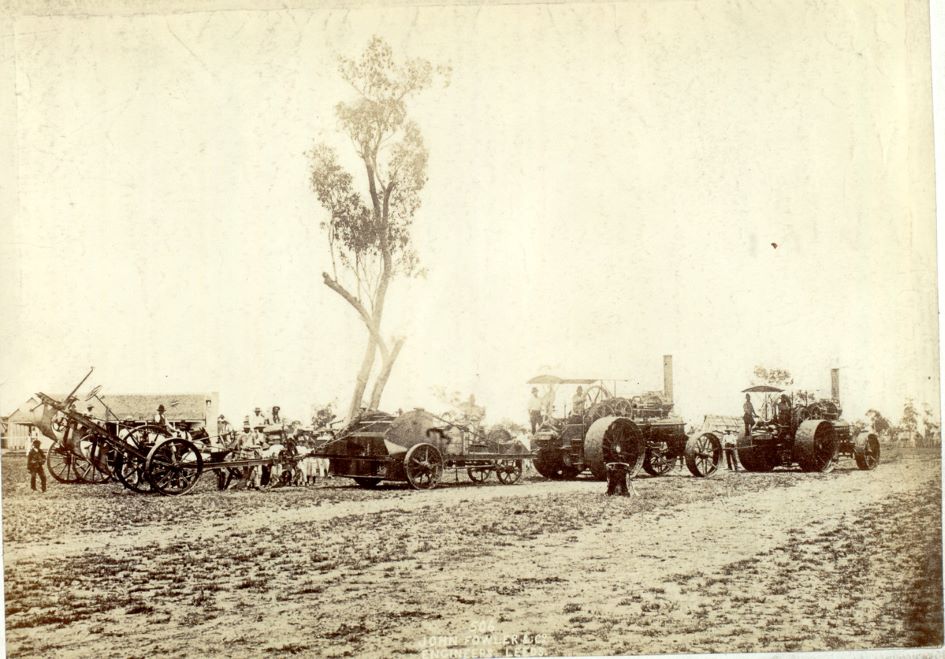
Australia
David Greig, a long-time businessman for Fowler, undertook a sales trip to Australia in 1889. His efforts resulted in the establishment of an agency in Sydney, which eventually became a subsidiary company in 1913. Fowler traction engines were exceptionally popular in Australia, and railway locomotives were also sold to sugar plantations for transportation purposes.
However, UK agricultural exports generally struggled against American competition, such as the Buffalo-Pitts company who effectively cornered the threshing machine market.
The image shows a pair of ploughing engines fitted with tackle for dam scooping in Australia.
TR FOW PH2/2/W506
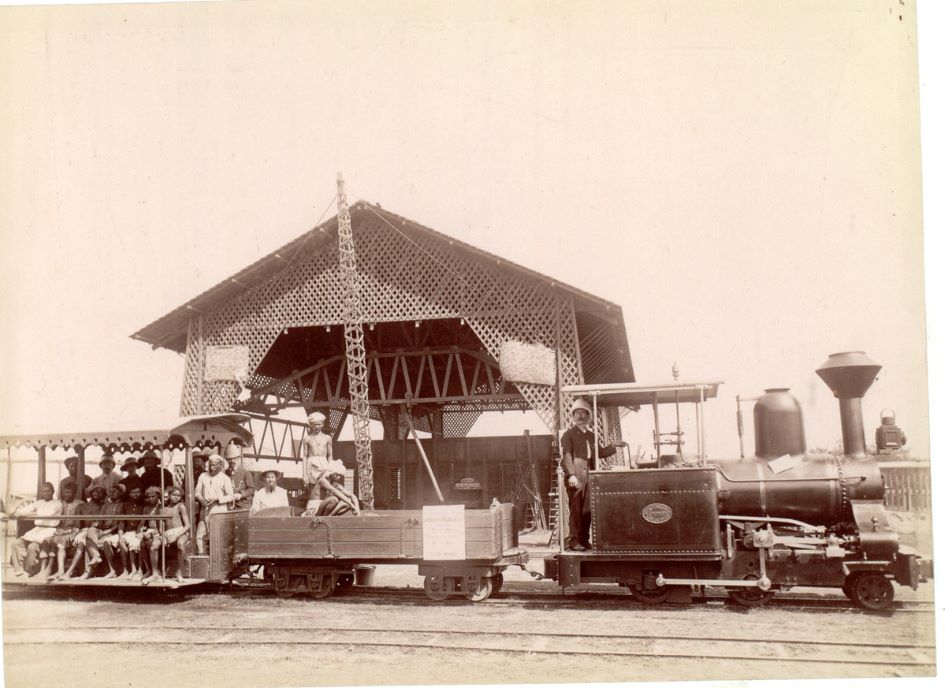
India
Forty goods engines were made by Fowler for the Great Indian Peninsular Railway, which was the first public railway on the Indian sub-continent. They were delivered between 1866 and 1868.
In later years, the India Office came to appreciate the ability of Fowler traction engines to haul heavy loads, and they were used extensively by the military. Between 1900 and 1910, Fowler road engines and road rollers were highly popular. Such was the volume of orders that a branch of the company was opened in Bombay in 1910.
This image shows a narrow gauge locomotive carrying Indian workers.
TR FOW PH2/2/W515A

Trinidad
In 1904, a set of Fowler ploughing engines and implements were sent to Trinidad to work on cane beds. A representative of Fowler, Alf Pepper, was tasked with both delivering the equipment and training the local workers to use it. As well as ploughing already cultivated land, they were also tasked with tackling ‘savanagh’ land that was previously unused. Though it was difficult going – amongst other issues, the ploughs ran into buried trees and then required repairs – 200 acres had been reclaimed by the time that Alf left, and the project continued without him.
The across image shows a ditching plough at work in Trinidad.
TR FOW PH2/4/A418
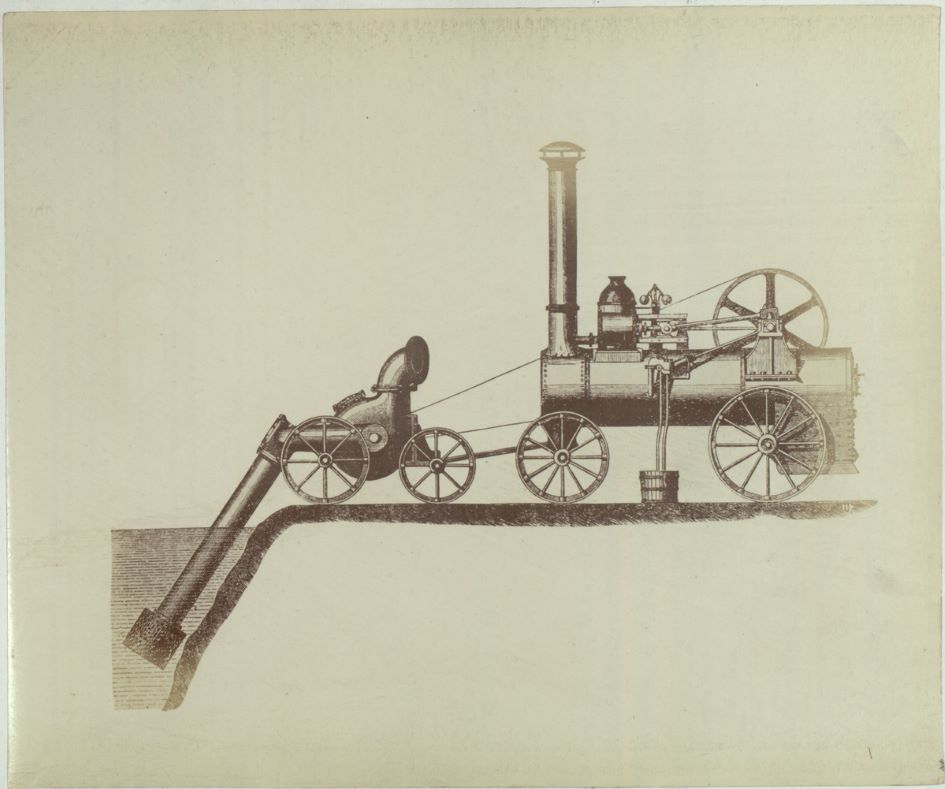
Egypt
One of the first examples of Fowler engines seeing use internationally was their export to Egypt. In the 1860s, Said Pasha ordered a hundred engines to replace his draft animals, which had been struck down by disease. Fowler steam ploughs were also useful for the growth of the Egyptian cotton farming industry.
This image is an engraving of a portable steam engine with a centrifugal pump, commissioned for irrigation in Egypt.
TR FOW PH2_1_100
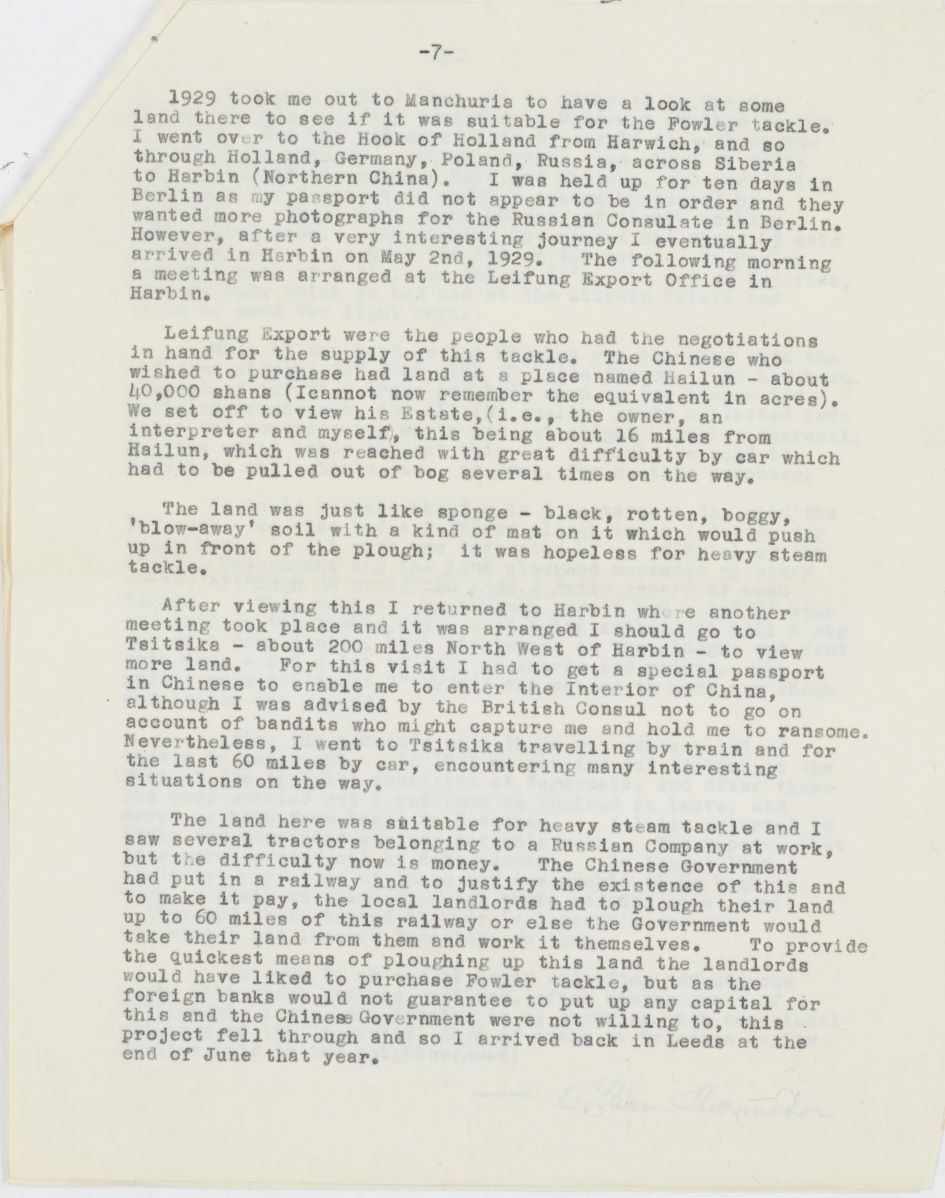
China
In the second half of the nineteenth century, agricultural crises caused widespread famine in Qing China. Chinese scholars (such as Feng Guifen) saw steam powered machinery as the answer. The Chinese Scientific and Industrial Magazine featured Fowler machinery as an example of how China could adopt these methods. One such advert showed a Fowler steam plow surrounded by other implements for “plowing, pumping water, hauling manure, as well as for mining and dredging”.
Even though steam powered machinery did not become widespread in China’s agricultural landscape until the twentieth century, Fowler was essential to spreading awareness which encouraged many Chinese scholars and journalists to push for state reform of agriculture.
This document is a memoir written by William Harmston, a Fowler engineer, relating to his business ventures in China.
D DX 2124
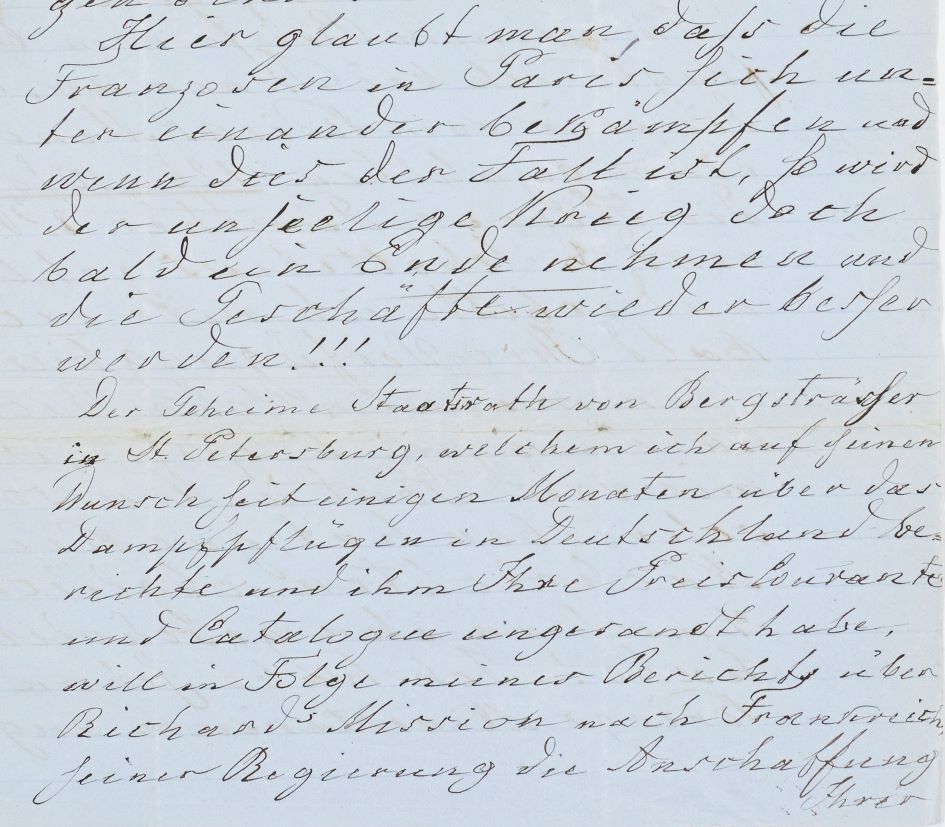
Prussia / Germany
Mr Richard Toepfler, a German who emigrated to England, became John Fowler’s apprentice in 1862. During the Franco-Prussian war, he adapted Fowler engines to use them in a military capacity. At Metz, for example, he used them to haul his artillery into advantageous positions to bombard the enemy. After receiving the Iron Cross, Toepfler’s reputation helped him to promote Fowler engines all over the continent, especially Germany.
He set up a head office in Magdeburg, and began cultivating heath land, using similar techniques to the Duke of Sutherland in Scotland. He worked closely with the German Agricultural Society.
This image is a part of a letter sent from Richard’s father (Gustav) to Robert Fowler in September 1870. He is giving an update on the Franco-Prussian War and informing Fowler that he has been in touch with Privy Councillor von Bergsträber about steam ploughing in Germany.
TR FOW AD7/11
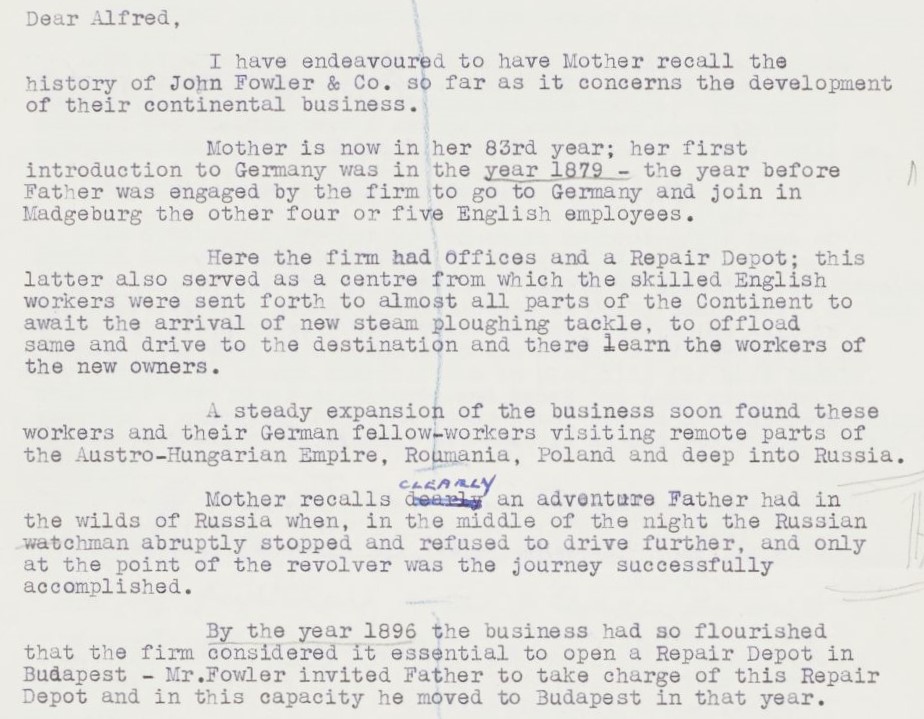
Russia
Eight special ploughing engines were sent to Russia in 1876. They had works numbers 2877-2884 and were suitable for straw burning. A number of further engines were dispatched to Russia in the following years. One woman, whose husband worked for Fowler, recalled an adventure he had whilst conducting business in Russia. Her thoughts are shown in the document opposite.
Fowler agreed a particularly large contract with the Russian government in 1915. This included 168 road engines. However, only a portion of this number were sent to Russia and all were lost in the Masurian swamps after the German army captured the region.
TR FOW SP1/2/xiii
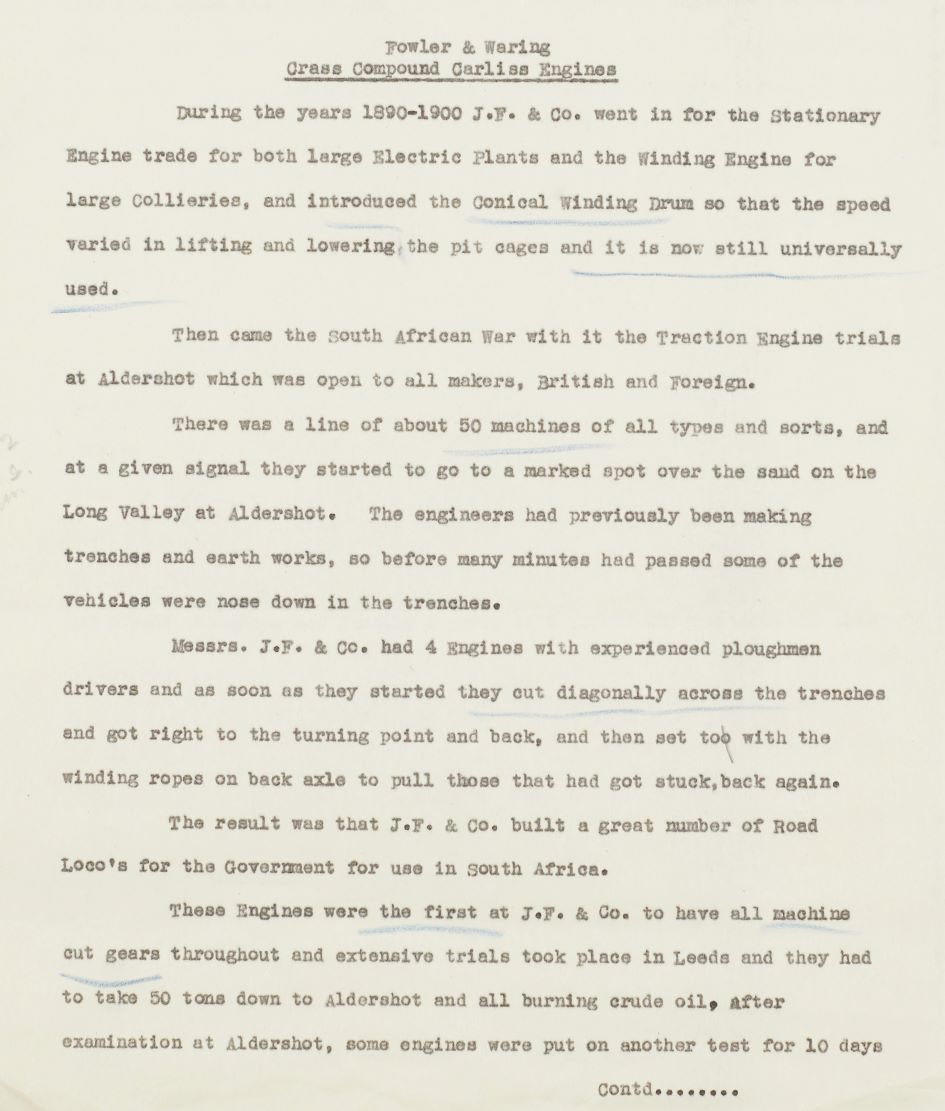
South Africa
In 1887 Fowler made an agreement with Otto von Lenz of Johannesburg and forwarded £1200 for the start of his new company. The first Fowler ploughing engines were imported into South Africa in 1891, encouraged by the discovery of coal in Cape Province. They operated along the Vaal river.
However, agriculture was not the only use for Fowler engines in South Africa. Alf Pepper, who worked for Fowler for 50 years, recalled that many Fowler road locomotives were dispatched there to play a role in the Boer war. Some engines had “armour plate” and “a Howitzer gun”.
TR FOW SP1/2/xii
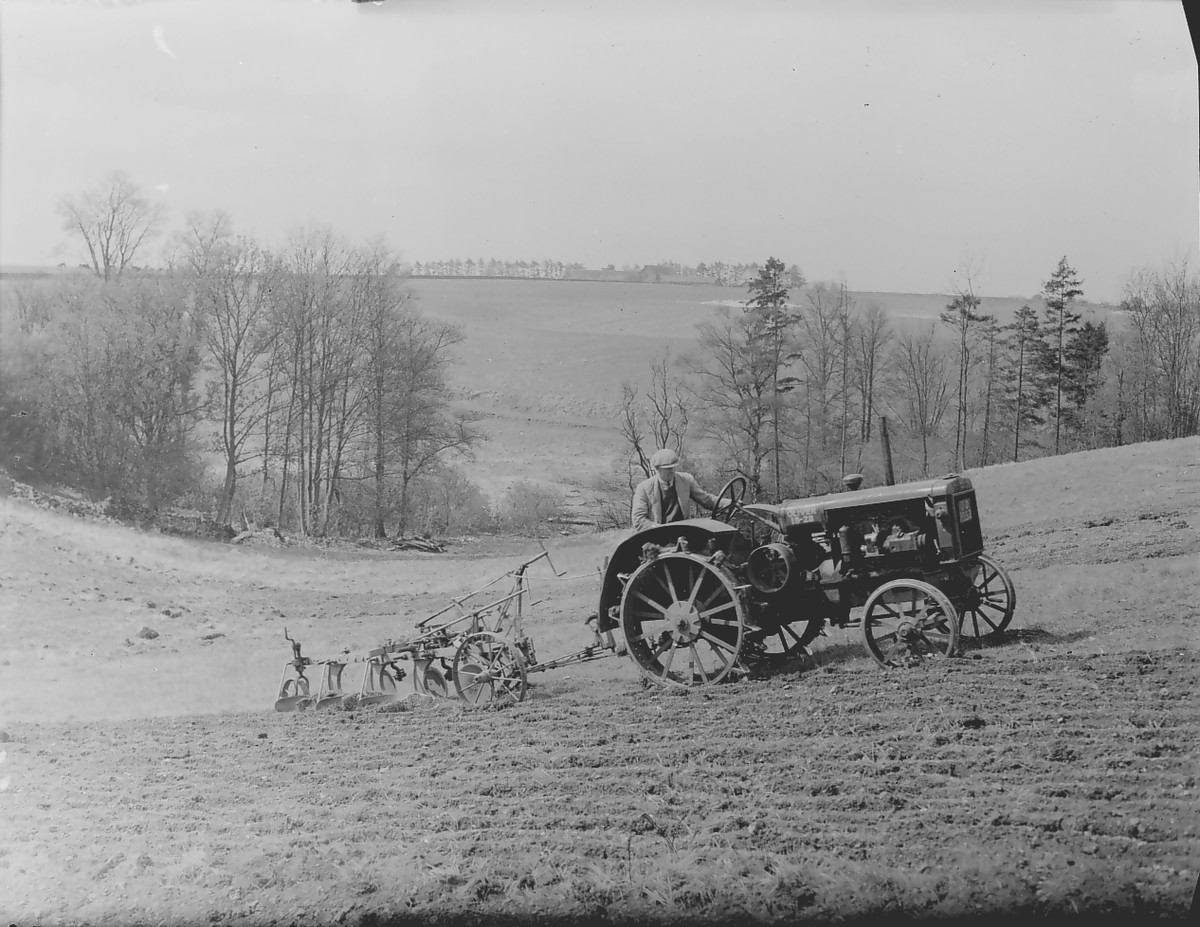
The Decline of Fowler and Steam Ploughing
Steam cultivation was comparatively specialised activity. It worked best in certain soil conditions and where the land was flat and fields larger, typically in the eastern counties.
The UK Government was concerned about the threat to food production posed by German submarines, so they ordered 60 sets of ploughing engines from Fowlers which were then issued to contractors.
The introduction of the internal combustion tractor in the earlier years of the 20th century largely replaced the horse in most of the country. It was far cheaper to operate than steam tackle. Nevertheless, until tractors became more powerful, the steam plougher still had its place in certain parts of the country. It had a renaissance in the second world war to increase food production but soon disappeared after peace came. Because of the power and utility of the cable worked implement was still considered valuable, from the 1930s a few steam ploughing engines had been converted to diesel. Some survive in this form.
The last steam contractor, John Patten, held on in Essex and Suffolk but the firm was wound up after his death in 1960 with many of the engines scrapped.
Developments with the internal combustion engine, a hydraulic system for attaching implements and cheaper production methods made the tractor a truly viable alternative to steam power on the farm and they gradually became the familiar sight they are in the farming landscape today.
P DX 289/0778
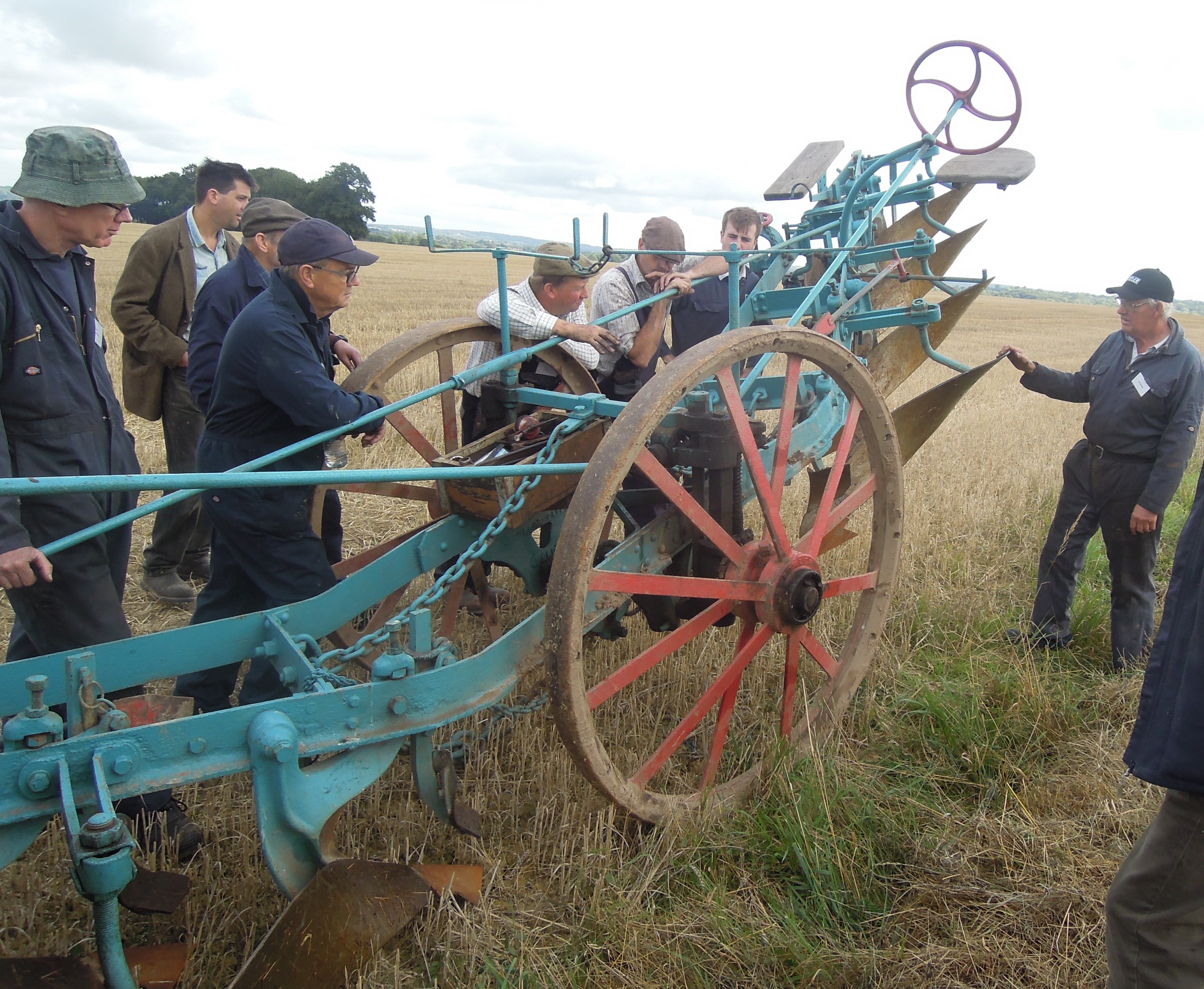
The Steam Plough Club
The Steam Plough Club
Founded in 1966 by the late Harold Bonnett, the Steam Plough Club is about keeping the tackle operating; not just the machinery but passing on the old and vital skills too. It maintains archival records, provides technical advice, gives instruction and help to today’s tackle owners, and runs competitions for the best work at the cable plough, just like the earlier days of the 1850s. John Fowler & Co’s machinery forms the bedrock of the club’s activities, as the majority of machinery surviving today was Fowler-made. However, makers like Burrell, Howard, and McLaren are not forgotten.
The SPC produces a quarterly journal for its members, the Steam Plough Times, and has a must-visit website at https://www.steamploughclub.org.uk.
With great thanks to the Steam Plough Club for their contributions of knowledge and time in developing this exhibition.
Photo credit to John Billard